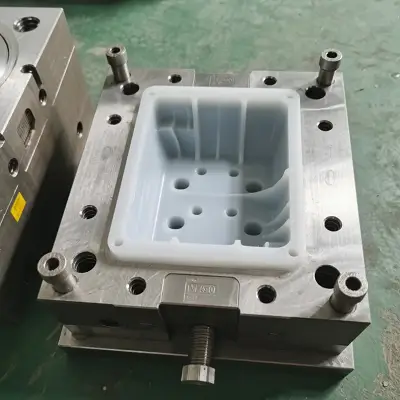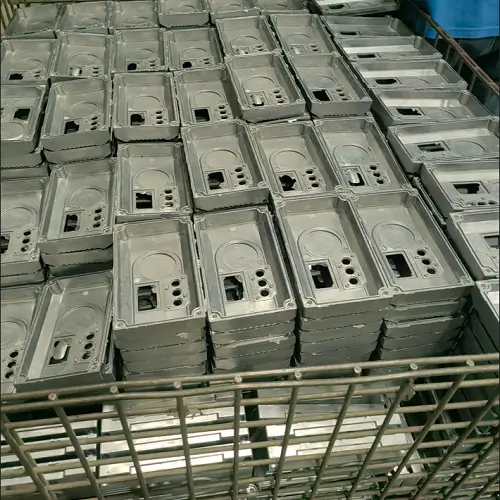As product development cycles keep getting shorter, many engineers, including our team at Jeek, often turn to vacuum casting as a quick, cost-effective way to produce small batches of high-quality plastic components. This method is commonly used to create prototypes or conduct market testing before investing heavily in mass production tooling.
Unlike injection molding, vacuum casting doesn’t use expensive metal molds. Instead, silicone molds are used, enabling rapid turnaround times for batches of approximately 5 to 50 pieces. The process is particularly effective for parts with intricate designs, high surface quality demands, or flexible design iterations.
This guide will explain clearly what vacuum casting involves, suitable materials, design considerations, and typical applications. We’ll also compare vacuum casting directly with CNC machining, injection molding, 3D printing, and urethane casting, helping you determine the most appropriate method for your project.

What Is Vacuum Casting?
Vacuum casting is a process that uses silicone molds to produce low volumes of plastic parts. At Jeek, we mainly use this method to manufacture polyurethane components with high surface finish and dimensional precision. The process involves casting in a vacuum environment, which eliminates air bubbles and ensures the mold cavity is completely filled, producing parts that closely resemble injection-molded plastics in both appearance and texture.
Unlike traditional injection molding, which requires time-consuming and costly metal molds, silicone molds can be created in just a few days. Each mold can be reused for 10 to 50 castings, making this technique ideal for prototyping, functional testing, and small-batch trial production once the design file is submitted.
In practice, we mix and degas the liquid polyurethane resin before pouring it into the silicone mold. The casting and curing take place under vacuum, allowing for high-quality parts even with complex geometries, undercuts, or embedded inserts.
While vacuum casting offers significant advantages in flexibility and surface quality, the process is still largely manual. As a result, it has some limitations in dimensional tolerance and scalability compared to injection molding, making it more suited for prototyping, custom production, and early-stage testing—not large-scale manufacturing.
Vacuum Casting Process & Steps(Click here for detailed guide)
Vacuum Casting Materials
As mentioned, polyurethane resin is the primary material used in vacuum casting. Below is a breakdown of available materials, categorized by type: rigid plastics, elastomers, and specialty resins for high temperature or optical clarity.
Rigid Plastics
ABS-like resin: Good impact resistance and dimensional stability; commonly used for enclosures and structural parts.
PC-like resin: Offers high transparency and impact resistance; ideal for lenses and protective covers.
PP-like resin: Excellent flexibility; suitable for snap fits and moving joints.
PA (Nylon)-like resin: Used where higher mechanical strength and heat resistance are required.
Elastomers
Flexible polyurethane: Can mimic rubber or TPU; ideal for seals, buttons, gaskets, and other soft components.
Specialty Materials
These include high-performance resins for specific requirements, such as:
High-temperature resistant resins
Flame-retardant PU
Optical-grade transparent resins
Vacuum Casting vs Urethane Casting: What’s the Difference?
Many engineers confuse vacuum casting and urethane casting. Urethane casting specifically refers to parts made with polyurethane (PU) resin. Vacuum casting, however, is a manufacturing technique utilizing vacuum to eliminate air bubbles when casting PU or other resins. Thus, all urethane cast parts are not necessarily vacuum-cast, but vacuum casting is commonly used for urethane parts to achieve higher quality and precision.
Key Technical Specifications of Vacuum Casting
| Parameter | Typical Range |
|---|---|
| Dimensional Accuracy | ±0.15 mm |
| Surface Roughness | Ra 0.8–1.6 μm |
| Maximum Part Size | 1000×800×500 mm |
| Minimum Wall Thickness | 0.75 mm |
| Mold Lifespan | 10–50 pieces |
Common Vacuum Casting Issues and Solutions
Air Bubbles or Voids
Improve vacuum degassing and mold venting processes.
Surface Roughness
Enhance silicone mold surface quality and optimize mold-release agents.
Dimensional Inaccuracy
Precisely control the resin mixture ratio and ensure proper curing time and temperature.

Comparing Vacuum Casting with Other Manufacturing Processes
During product development, different manufacturing methods offer different strengths. Here’s how vacuum casting compares to CNC machining, injection molding, and 3D printing:
Vacuum Casting vs CNC Machining
CNC machining offers high precision and is excellent for producing metal and plastic parts by subtractive methods. However, it is relatively costly and time-consuming, and it struggles with complex undercuts or internal cavities. Vacuum casting, while less precise, excels in handling complex shapes and internal features by using flexible molds.
Vacuum Casting vs Injection Molding
While both methods involve molding, the key difference lies in the mold itself. Injection molding requires metal molds, which are expensive and time-intensive to create—ideal for mass production. Vacuum casting, on the other hand, uses silicone molds that are quick and affordable to produce, making it far better suited for low-volume runs, rapid iterations, and early-stage testing.
Vacuum Casting vs 3D Printing
3D printing is known for speed and design freedom, but the resulting parts often show layer lines and require time-consuming post-processing. Vacuum casting delivers superior surface finish, closer to that of production-grade parts, making it ideal for presentation models and customer demos.
In short, vacuum casting is an excellent choice for quick-turn functional prototypes and small-scale production runs, helping engineers reduce time-to-market without compromising quality.
Limitations of Vacuum Casting
Despite its advantages in speed, flexibility, and cost, vacuum casting has a few inherent limitations:
Limited mold lifespan: Each silicone mold can typically withstand only 10 to 50 castings, restricting its use to small-batch production.
Lower dimensional accuracy: The manual nature of the process leads to greater variability compared to CNC or injection molding.
Material constraints: Vacuum casting is primarily for plastic parts; it’s not suitable for metal production.
Design limitations: Thin walls, sharp corners, and deep holes may not be viable and might require CNC machining or SLS printing to complement the process.
Practical Applications of Vacuum Casting in Different Industries
| Industry | Application Scenarios |
|---|---|
| Automotive Manufacturing | Design verification components such as instrument panels, door trims, and glove compartments; functional parts including headlamp housings, air intakes, and ventilation system components. |
| Consumer Electronics | Prototyping of new product enclosures, such as phone cases, earbud charging cases, wearable device frames, as well as interactive prototype components like electronic switches and knobs. |
| Medical Devices | Used to produce diagnostic equipment housings, handheld device enclosures, custom braces, and functional models for clinical trials or user feedback evaluation. |
| Aerospace | Suitable for rapidly creating interior components such as seat covers, in-cabin air ducts, avionics cover panels, or other non-load-bearing decorative parts. |
| Food Packaging & Household Products | Development of sample packaging containers, including bottle caps and food box structure prototypes, as well as visual evaluation models for small home appliances. |
By leveraging vacuum casting, the Jeek team can rapidly validate part appearance, structure, and user interaction, significantly accelerating the product development cycle. If you’re ready to build a prototype, just send us your design files—we support all manufacturing methods including CNC machining, 3D printing, injection molding, metal forming, and of course, vacuum casting.
At Jeek, we understand the uncertainty and time pressure that come with early-stage product development. Vacuum casting is tailor-made for this phase. It enables engineers to produce functional prototypes or display-ready models without compromising quality or incurring the high costs of traditional tooling. With its cost-efficiency and ability to reproduce complex geometries and surface details, vacuum casting lays a solid foundation for testing and iteration.
If you’re looking for a flexible, fast, and reliable method to bring your concept to life, feel free to contact us for a quote. At Jeek, we’re not just a manufacturing provider—we’re your technical partner on the path to market success.
Frequently Asked Questions about Vacuum Casting
1: What is vacuum casting primarily used for?
A: Prototyping, market validation, and small-batch plastic parts.
2: Can vacuum casting produce transparent parts?
A: Yes, using specialized optical-grade resins.
3: What tolerances can vacuum casting achieve?
A: Typical accuracy is ±0.15 to ±0.2 mm.
4: How long does vacuum casting take per part?
A: Typically, 1-3 hours per cycle after mold preparation.
5: Is vacuum casting more cost-effective than injection molding?
A: Yes, especially for low-volume runs under 50 units due to lower mold costs.


